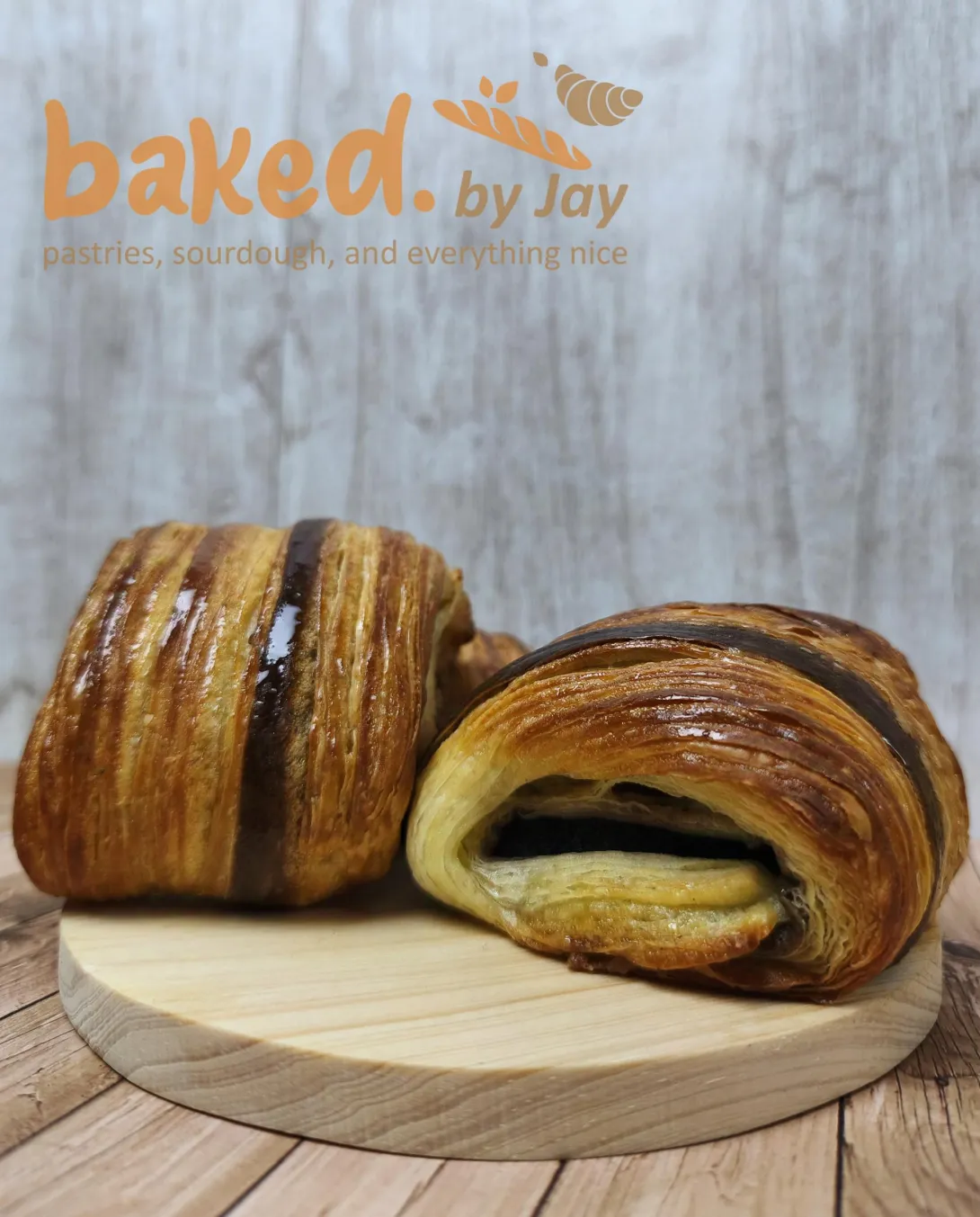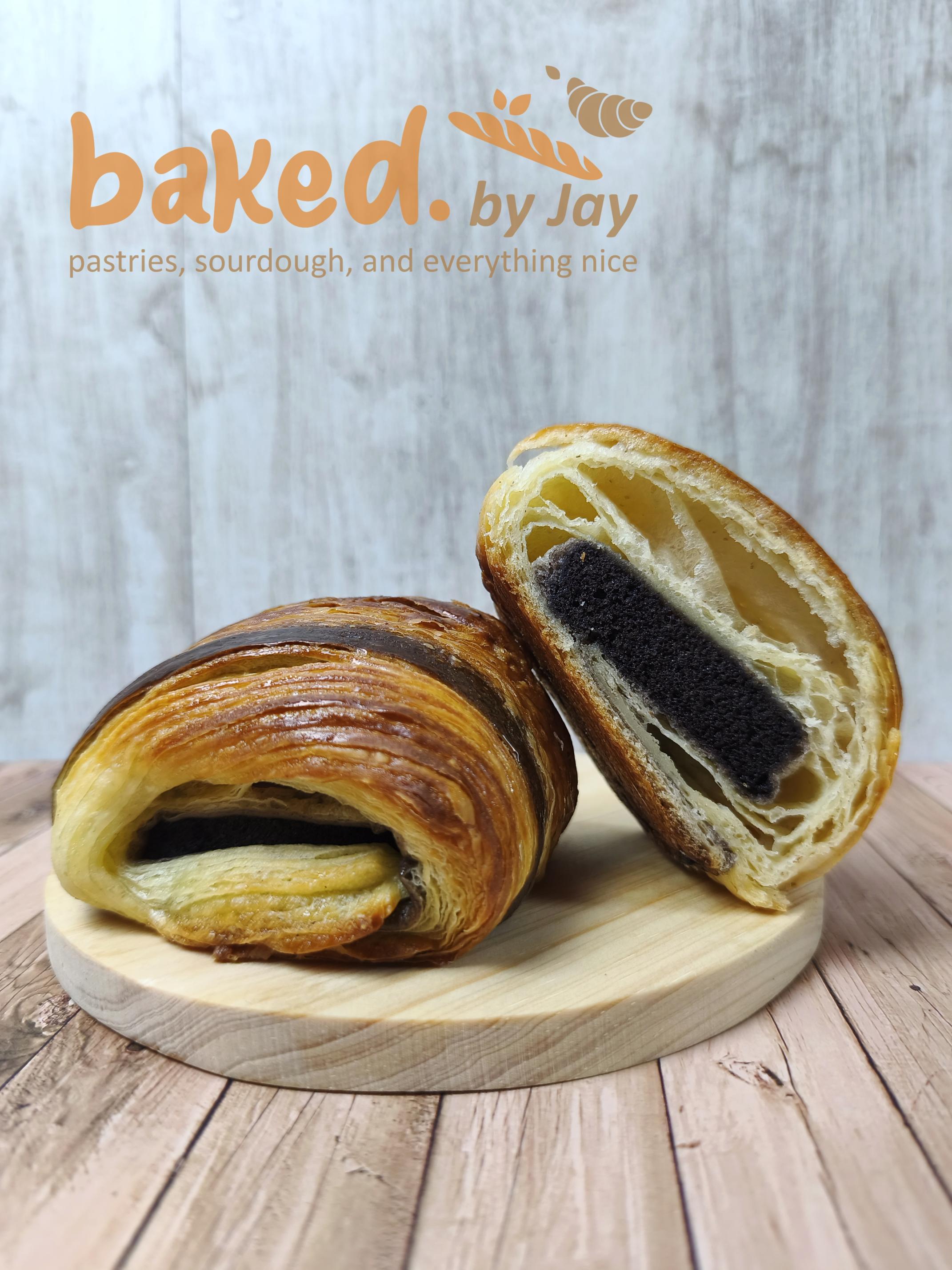
This is my first practice batch for my second viennoiserie product, coconut glazed black rice pain Suisse. It's basically croissant dough, with pattern made out of sliced dough. It's bicolor dough, the second dough is black rice dough. Instead of taking bit of main dough and knead it with rice flour like my previous chocolate croissants, I made a whole new dough, just because I hate kneading lol.
The filling is steamed black rice pound cake, an Indonesian classic of tea cakes. It's gluten free by default, and just the good old ratio of pound cake, except I cut sugar by half, since the pastries themselves already have sweet glaze. The retained moisture from steaming allowed me to cut sugar without worrying about moisture (I isolated the cake pan from steaming moisture by wrapping the cake pan in cling wrap). I did reversed creaming method (creaming the flour instead of creaming the eggs). The idea is to prevent the flour from sinking (because fat floats on water). I steamed it so it doesn't dry out during baking.
The idea of cake filling came from me being frustrated about pastry cream filling of pain suisse that always leaked during baking, and also inspired by brownie filled pain au chocolat I saw on youtube. So why not black rice cake, I thought.
I still struggle with crumb aesthetic when it comes to pain Suisse. There is considerable amount of time at room temperature needed to do dough make up, and that's the weak link if using freezer method for pain suisse (can't wait to have dough sheeter!)
If you feel like trying, lower the upper burner by 20 °C than you would with croissants, since the ridges are easier to burn.
Fixes I would do in the next practice batch:
- less cake portioning (and thinner slices, the portioning was a bit off)
- do 3+4 lamination instead of 4+4 (the main dough basically sandwiched between another doughs, prolly got too squished during final roll)
- after dough make up, I would freeze for 45 minutes to stop fermentation, then move to fridge and check every 30 minutes whether it's cold enough but still pliable.
- I definitely will put more black rice in second dough, the color was not dark enough.
- I would change the order of layers from ridges-main dough-rice dough to ridges-rice dough-main dough
Best regards,
Jay

- WanyeKest's Blog
- Log in or register to post comments
Great looking pastries! It's getting so when I see a photo I can tell it's one of yours!
TomP
Thanks Tom, Appreciate it! And such a flattering comment
I'm just trying to bring more color to TFL, hopefully it works! :)
Jay
just when my partner's trying to get me to give up pastries .... these look fantastic, Jay.
Rob
Thanks Rob, appreciate it!
And good thing I'm not Aussie, they might have different idea about the word pavlova 😆
Jay
Another really informative post and a really creative, well executed bake. Looks utterly delicious and so beautiful. The contrast between the pastry and the black rice cake is excellent, and I like that you really gave the cake a lot of thought too. I would so love to be able to try this.
I'm confused about the reverse creaming, could you help me understand? So the creaming of the butter with sugar aerates the crumb, and then you cream the flour into it first rather than eggs, because you want the flour to "bind" to fat, so that it doesn't sink when you steam it? How long is the creaming of the flour? And I suppose we would be concerned doing this with a normal pound cake because we would be building up gluten by creaming the flour? Sorry if I'm going completely off track here.
Thanks Lin, appreciate your kind and thoughtful words!
So, regarding reversed creaming. My goal was to create cake that is dense and tender, almost like brownie. I don't want fluffy cake for that, because the cake is not a vessel to filling, it is the filling
Reversed creaming usually done for such purpose. After dry ingredients thoroughly mixed with fat, wet ingredients are added, then mixed on high speed for 3 minutes. Such mixing time is needed to build structure because the wheat flour is heavily coated in fat.
As for black rice? There is no strength to build to begin with. I kept mixing short and eggs added gradually, just enough to emulsify. The batter was thick and even, the cake has even texture from top to bottom, the texture was tender and dense as intended.
I've seen various recipes of it using different techniques and ratios, with basic creaming, with egg foaming, less fat, with coconut milk. So I guess if it all worked for them, maybe doesn't matter to reversed or not.
One thing to note though, the end product was really filling. There are several posibilities I would do for a change:
Make black rice pudding. Pipe the filling to dough strips before folding. It'll be closely resemble classic custard filled pain Suisse. I imagine this will make superior flavored end product, but may leak liquid during baking (unless after making the pudding, you bake the pudding with eggs, and slice the pudding to be used as filling
I chose pound cake because it has the most flour percentage relative to total weight, and I want the flour to really shine. So among those solutions, I would choose the first one. Just be light with syrup/jam glaze. Shiny enough, and not cloying sweet
Jay
Hi Jay,
I've been marveling at this one for some days, and once again have been learning wonderful new things from the baking knowledge you've been sharing.
I think though that I'm missing some basic things when it comes to the black rice. I assume you're using a flour of it in the pound cake, but is it a flour you're using. And, is it glutinous (sticky) or not?
-Jon
Thanks for your kind words, Jon. Appreciate it!
Traditionally always been glutinous black rice flour. The regular black rice flour I found is rare anyway.
Jay
I would do black rice pudding too. It could be piped right away on dough strips, or baked with egg(s) mixed in, then slice the pudding as filling. That way, the egg will bind the liquid, so no leak during pain suisse baking. I imagine this would be a lot lighter than pound cake
My concern would be, the black rice flavor could be too diluted. The rice grains themselves need to be cooked with water 4 times the dry weight, then coconut milk, then eggs and sugar.
Jay
I get it now and understand the mechanism behind reverse creaming. Yet another thing learnt. Thanks, Jay!
I feel like in terms of texture contrast and flavour intensity, what you've chosen here should work really well, and personally I think definitely better than the other cake options. Indeed, thinner slices as you've suggested might well make it less filling, especially if they are already pretty much a flavour bomb. The black rice pudding option is also really interesting and as attractive in its own right, but I just wonder if from a baking perspective it's a little more finnicky? Or what about black rice mochi - imagine biting into it and having to stretch it out due to the elastic filling ;D
Well, I think the original pain suisse is already fussy 😆(the pastry cream + chocolate chip one). And aside for both having more similar mouthfeel, black rice pudding happened to be traditional too in here, usually served with a bowl of sweetened mungbean soup
I'm personally not a fan of mochi-like texture in flaky pastries, and I think mochi would be phenomenal in chocolate covered bars! Or hidden in tarte au chocolat!
Jay
These are quite unique to me, I've never seen anything quite like this. They are delicious I am sure.
Benny
Thanks, Benny! appreciate it
Jay
deleted